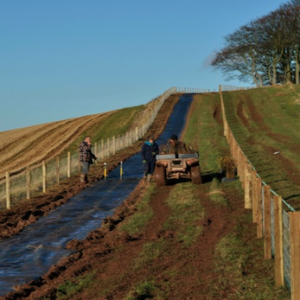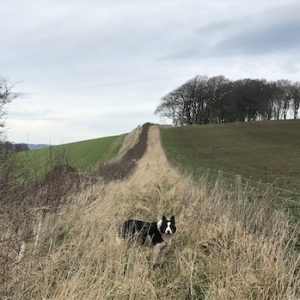This is the beginning of a story of Hedgerow creation in a local farm landscape.
The East Berwickshire Hedgerow Creation project is a Nature Restoration Fund (Scottish Government), project initiated at Peelham by the Waltons and shared with three of their neighbours. It will see 11.424kms of thick hedgerow planted in two years with 3.0m wide, species rich hedgerows of nine native shrubs including holly.
New internal hedgerow boundaries will create smaller fields and a new hedged local landscape. Hedgerows will link-in with existing habitats including the existing 6kms of hedgerows planted by the Waltons at Peelham over the last 20 years. A dense central network of connected hedgerows will concentrate at Peelham Farm with hedgerow corridors extending to the wider local countryside through neighbouring farms connecting with habitats in the locality. It involves a collaboration between four farms (including Peelham).
The project priority is HABITAT AND SPECIES RESTORATION; The hedgerows will be created and managed to create pollinator, bird and small mammal habitat with considerable potential to contribute to the arrest of further decline of farmland biodiversity in the locality. Hedgerows are a priority habitat for 12 of the UKs most threatened bird species of which five breed at Peelham (RSPB and volunteer breeding bird surveys).
Hedgehogs are a small mammal in most serious decline (50% in rural areas) using hedgerows as important sources of food and shelter. Hedgerows support upto 30% of our butterflies. These continue to be vulnerable to intensive agricultural practices in the wider landscape and the degeneration of farmland habitats including hedgerows. Linear features such as intimately connected hedgerows are important for bats (70% decline in the Common Pipistrelle for example), the networked hedges linked to other habitats would increase roosting and foraging capacity.
It will also assist locally in the adaptation to and mitigation from, the impacts of CLIMATE CHANGE; The UK Climate Change Committee recommends the increase of the UK’s hedgerows by 40% to help contribute to Net Zero. Recent research shows that a hectare of mature hedgerows has been found to sequester 131.5t of Carbon per ha (Ref ‘Hedge Fund’ CPRE, 2021). The 11.424kms we plant has the potential of drawing down 450t C per year. The slowing and filtering of strong winds and heavy rain at ground-level will shelter and protect wildlife, vegetation, livestock and soils. This has become particularly important since the destruction of mature woodland by Storm Arwen. The accumulation of leaf l itter from the hedgerow shrubs will benefit soil condition and biodiversity.
itter from the hedgerow shrubs will benefit soil condition and biodiversity.
We would expect to see an increase in farmland birds and invertebrates within 5-10 years and an increase in soil biodiversity and organic matter within 10 years.
This is a significant project which is building structural resilience into a local farmland landscape (317ha). It will increase hedgerow length by 11,424m (from 6581m) and importantly hedgerow density by 37% from 20.76m/ha to 56.80m/ha. It is delivering a Public Good and better farming practice in a food-producing local environment.
The project includes engagement with individuals and communities who would like to volunteer.




 itter from the hedgerow shrubs will benefit soil condition and biodiversity.
itter from the hedgerow shrubs will benefit soil condition and biodiversity.